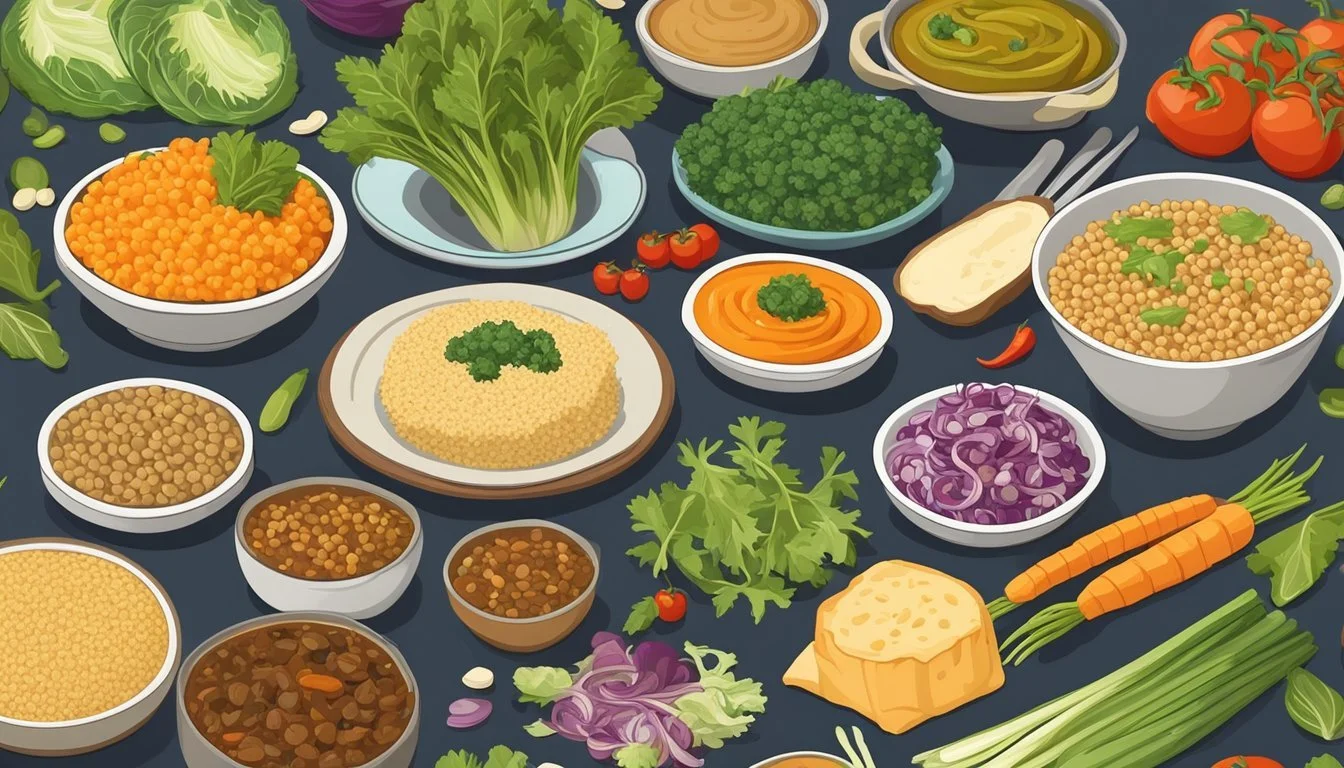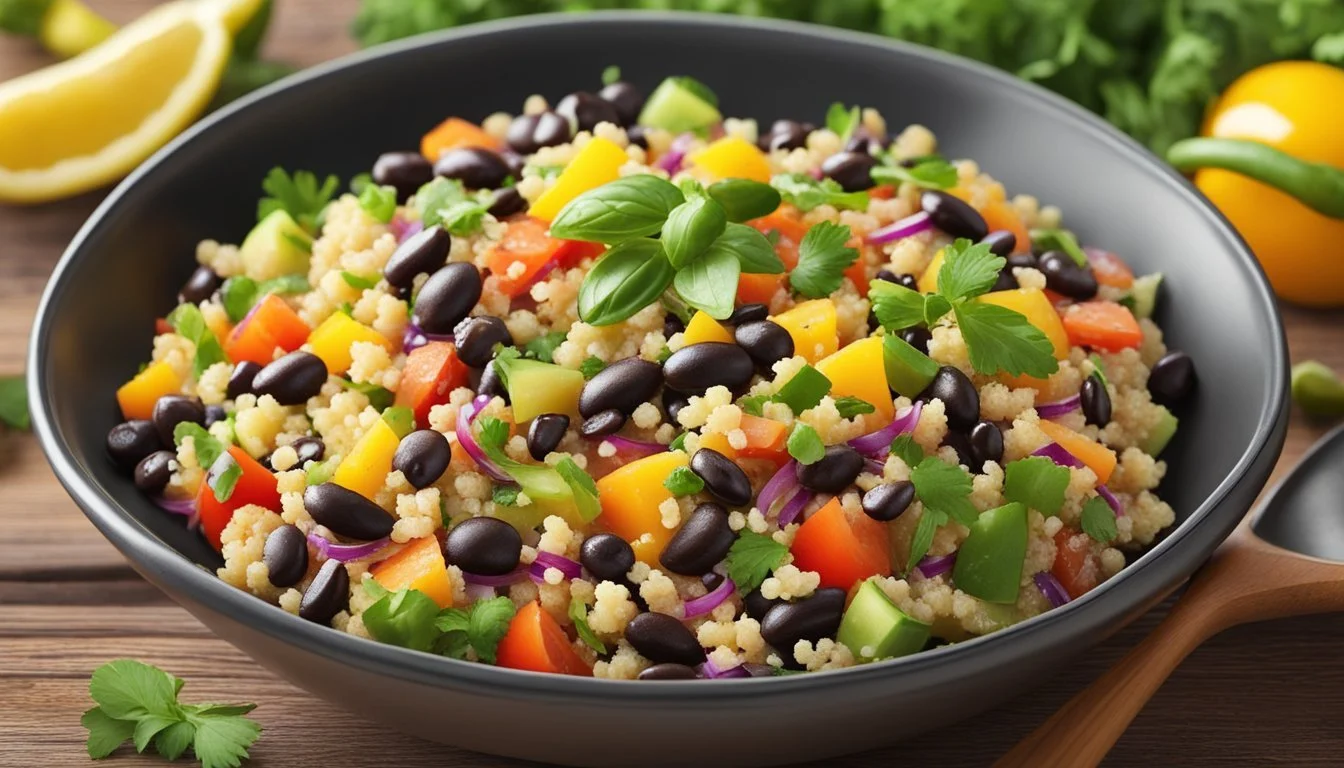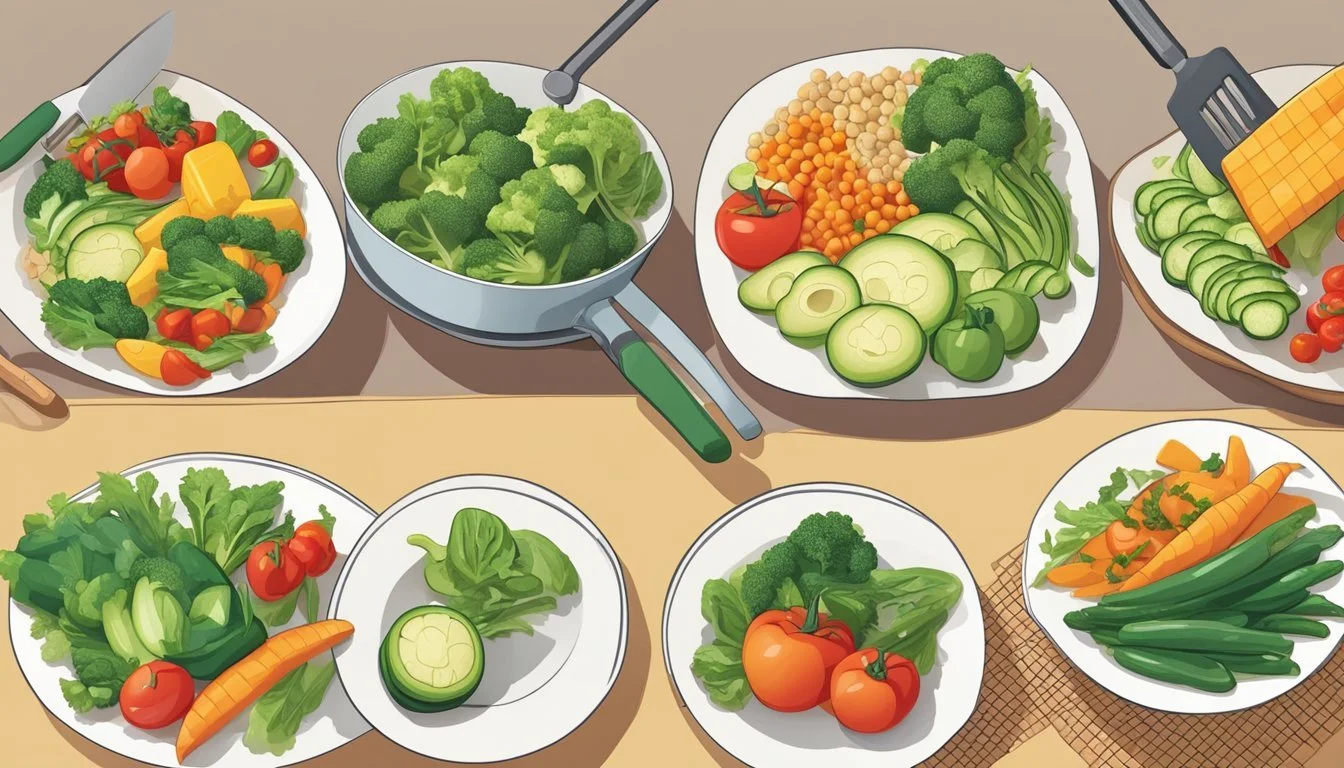9 Tasty Vegetarian Meals for People with Diabetes
Healthy and Delicious Options
Managing diabetes while following a vegetarian diet is entirely possible and can be both healthy and satisfying. A vegetarian diet rich in vegetables, whole grains, and legumes provides essential nutrients that support overall health and stable blood glucose levels. Choosing diabetic-friendly meals that are both nutritious and delicious ensures that individuals with diabetes can enjoy a variety of flavors without compromising their dietary needs.
By incorporating plant-based proteins and fiber-rich foods, those with diabetes can create balanced meals that help maintain energy levels and prevent blood sugar spikes. The following article highlights nine delectable vegetarian meals specifically designed for people with diabetes, showcasing the diversity and richness of a meat-free diet while catering to their specific health requirements.
1) Vegetable Stir-Fry with Tofu
Vegetable stir-fry with tofu is a versatile and nutritious meal suitable for people with diabetes. The dish combines a variety of colorful vegetables with protein-rich tofu, making it both delicious and balanced.
To prepare, start by whisking together the stir-fry sauce ingredients in a small bowl. This typically includes soy sauce, sesame oil, garlic, and ginger.
Heat olive or sesame oil in a large skillet or wok over medium-high heat. Once hot, add the tofu cubes, cooking them undisturbed for 3-4 minutes to achieve a crispy texture before flipping to cook the other sides.
Remove the tofu and set it aside. In the same skillet, sauté onions and garlic for a couple of minutes until fragrant.
Add a variety of vegetables such as broccoli, red bell peppers, and mushrooms. Cook these for 5-7 minutes until they start to soften, stirring often.
Return the tofu to the skillet and pour in the stir-fry sauce. Toss everything together and let it cook for an additional 1-2 minutes until the sauce thickens slightly.
Vegetable stir-fry with tofu is best served hot, and it pairs well with brown rice or quinoa for an extra fiber boost. This meal provides essential nutrients and helps maintain healthy blood sugar levels.
2) Quinoa and Black Bean Salad
Quinoa and black bean salad is a nutritious and filling option for vegetarians with diabetes. This dish combines protein-packed quinoa with fiber-rich black beans, making it a great choice for maintaining steady blood sugar levels.
Quinoa cooks quickly, usually in about 15 minutes, making it a convenient base for this salad. Once cooked, it's important to let the quinoa cool to room temperature before mixing it with other ingredients to ensure the best texture.
Black beans add both flavor and nutritional balance to the salad. Draining and rinsing canned black beans helps reduce sodium content. Combining these beans with quinoa results in a meal rich in both protein and fiber.
To enhance the salad, add grilled vegetables like corn and zucchini. These add minimal extra calories and plenty of vitamins. Using a grill can add a smoky flavor that elevates the dish.
For a dressing, a simple mix of olive oil, lime juice, salt, and pepper works well. This dressing is light and complements the natural flavors of the quinoa and vegetables without overpowering them.
Chop vegetables like onions, bell peppers, and perhaps a bit of garlic for additional taste and nutritional benefits. Cooking these until tender before adding to the salad integrates the flavors better.
This salad is versatile and can be prepared ahead of time, making it ideal for meal prep. Storing it in the fridge also allows the flavors to meld together, enhancing the overall taste.
3) Cauliflower Rice with Lentils
Cauliflower rice with lentils is a nutritious and balanced option for those managing diabetes. This dish combines low-carb cauliflower rice with protein-packed lentils, helping to maintain stable blood sugar levels. The inclusion of vegetables further boosts its nutritional profile.
To prepare this dish, begin by heating a large skillet over medium heat. Add some oil and sauté thinly sliced shallots until they become crispy and brown. Remove the shallots and set them aside.
In the same skillet, add riced cauliflower and cook until tender, stirring occasionally. Incorporate precooked lentils and an Indian-style simmer sauce to add flavor. Serve the lentil curry over the cauliflower rice, and top with the crispy shallots for added crunch.
This meal is quick and requires minimal ingredients, making it ideal for busy weekdays. It’s also versatile; you can adjust the spices and vegetables according to personal preference.
Eating cauliflower rice with lentils provides a hearty meal that supports dietary needs for diabetes. This dish leverages the benefits of both cauliflower and lentils, offering a satisfying and health-conscious choice.
4) Spaghetti Squash Primavera
Spaghetti Squash Primavera is an excellent choice for a diabetes-friendly vegetarian meal. This dish is low in carbohydrates and calories, making it suitable for maintaining balanced blood sugar levels.
The preparation begins with preheating the oven to 400ºF (200ºC). Slice the spaghetti squash in half, drizzle with olive oil, and season with salt and pepper. Baking the squash cut-side down on parchment paper for about 40-50 minutes ensures it becomes tender.
Once cooked, use a fork to scrape out the spaghetti-like strands. This provides a base that is rich in fiber, helping to promote satiety and digestive health.
Incorporate a variety of vegetables like bell peppers, zucchini, and cherry tomatoes into the mix. Sauté these vegetables with garlic and olive oil until they are tender.
Mix the vegetable medley with the scraped spaghetti squash strands. To enhance the flavor, consider adding a sprinkle of fresh herbs like basil or parsley. Vegetarian, gluten-free, and packed with nutrients, this dish offers a hearty yet light option for dinner.
Spaghetti Squash Primavera combines taste and nutrition in a way that supports diabetes management while appealing to a diverse range of palates.
5) Chickpea and Spinach Curry
Chickpea and Spinach Curry is a flavorful and nutritious option for vegetarians with diabetes. Chickpeas provide a good source of protein and fiber, which can help manage blood sugar levels.
Spinach offers an array of vitamins and minerals, adding to the nutritional value. The combination of these ingredients creates a hearty and satisfying dish.
To prepare the curry, start by sautéing onions, garlic, and ginger in a bit of oil. Once softened, add your chosen spices like cumin, turmeric, and garam masala. The spices not only enhance the flavor but also have potential health benefits.
After the spices release their aroma, add crushed tomatoes to form the base of the curry. Incorporate chickpeas and allow them to simmer, absorbing the flavors of the spices and tomatoes.
Next, stir in coconut milk and let the mixture simmer to thicken. Finally, add chopped spinach and cook until it wilts. This step ensures the spinach retains its vibrant color and nutritional integrity.
Serve the Chickpea and Spinach Curry with a side of brown rice or quinoa for a complete meal. It’s a balanced dish that can fit well into a diabetes-friendly diet while offering a delicious culinary experience.
6) Grilled Portobello Mushrooms
Grilled Portobello mushrooms are an excellent choice for people with diabetes due to their meaty texture and low carbohydrate content. They provide essential nutrients like vitamin D, selenium, and potassium, which are beneficial for maintaining overall health.
To prepare grilled Portobello mushrooms, start by cleaning and removing the stems. Brush the caps with olive oil and season with salt and pepper. Grilling the mushrooms until they are tender enhances their rich, earthy flavor.
These grilled mushrooms can be served as a side dish or as a main course for a light meal. Pair them with a fresh salad or whole grains to create a balanced and satisfying dish. Their versatility makes them a staple in vegetarian cooking.
Adding a marinade, such as a simple mixture of olive oil, garlic, and herbs, can boost the flavor profile. Serve them with a tangy jalapeño chimichurri sauce to add a zesty kick that complements their natural umami taste.
7) Roasted Brussels Sprouts and Sweet Potatoes
Roasted Brussels sprouts and sweet potatoes offer a delicious and nutritious option for people with diabetes. This simple dish blends the natural flavors of the vegetables with subtle seasoning.
Preheat the oven to 400°F (204°C). Prepare the Brussels sprouts by trimming the ends and halving them. Peel and cut the sweet potatoes into 1-inch cubes.
In a large bowl, combine the Brussels sprouts and sweet potatoes with olive oil, garlic powder, cumin, paprika, salt, and pepper. Toss to coat evenly. Spread the vegetables in a single layer on a large baking sheet lined with parchment paper.
Roast the vegetables for 20-25 minutes, stirring halfway through to ensure even cooking. The veggies should be tender and slightly caramelized. These roasted vegetables make a great side dish or can be added to salads and bowls.
People with diabetes can enjoy this dish due to its low glycemic index and high fiber content. Additionally, Brussels sprouts are rich in vitamins C and K, while sweet potatoes provide beta-carotene and potassium. These nutrients help balance blood sugar levels and support overall health.
8) Veggie-Packed Minestrone Soup
Veggie-packed minestrone soup serves as a nutritious and delicious option for people with diabetes. This hearty soup is loaded with a variety of vegetables, beans, and pasta, providing plenty of fiber and essential nutrients.
Start by heating olive oil in a large pot over medium heat. Add chopped onions, garlic, carrots, celery, and zucchini. Sauté until the vegetables are tender.
Next, stir in vegetable broth and canned tomatoes. Add cannellini beans, kidney beans, and some chopped potatoes. Season with rosemary, oregano, and a bit of salt and pepper. Allow the soup to simmer for about 30 minutes.
During the last few minutes of cooking, add a small amount of pasta. Cook until the pasta is tender yet firm to the bite. Finally, stir in fresh spinach and parsley, allowing them to wilt into the soup.
This veggie-packed minestrone is not only flavorful but also offers a balanced meal. The combination of beans and vegetables ensures a good mix of proteins, vitamins, and minerals. It’s a perfect meal for anyone looking to enjoy a wholesome and diabetes-friendly dish.
9) Stuffed Bell Peppers with Brown Rice
Stuffed bell peppers with brown rice make a nutritious and satisfying meal option.
Brown rice is a whole grain that helps maintain steady blood sugar levels.
The bell peppers are rich in vitamins A and C, adding essential nutrients and vibrant color.
This dish can be customized with a variety of vegetables such as spinach, mushrooms, and tomatoes.
Adding beans or tofu increases the protein content, making it more filling and protein-rich.
Cheese can be added for extra flavor, although it should be used sparingly to manage calorie intake.
All ingredients work together to create a balanced meal suitable for people with diabetes.
Nutritional Guidelines for Vegetarians with Diabetes
Managing diabetes on a vegetarian diet requires careful attention to meal composition. Key aspects include balancing macronutrients, choosing low-glycemic foods, and ensuring adequate fiber intake.
Balancing Carbohydrates and Proteins
For vegetarians with diabetes, balancing carbohydrates and proteins is crucial. Complex carbohydrates like whole grains, legumes, and vegetables should be prioritized. These provide sustained energy without causing rapid spikes in blood sugar levels.
Incorporate plant-based proteins such as tofu, tempeh, legumes, and nuts. Aiming for a protein intake of around 4-6 ounces per day can help maintain muscle mass and satiety.
Examples of balanced meals:
Quinoa-Black Bean Salad: Quinoa for carbs and black beans for protein.
Spinach Alfredo Lasagna: Whole-grain pasta for carbs and cheese for protein.
Understanding Glycemic Index
The glycemic index (GI) measures how quickly foods raise blood sugar levels. Low-GI foods release glucose slowly, ensuring stable blood sugar levels. Whole grains, vegetables, nuts, and seeds typically have a low GI.
Lentils: rich in fiber and protein.
Sweet potatoes: a complex carbohydrate with a lower GI.
Apples and plums: fruits with moderate GI values when eaten whole.
Avoid high-GI foods like white bread, sugary cereals, and snacks. These can cause rapid blood sugar spikes, making diabetes management more challenging.
Importance of Fiber
Fiber plays a significant role in managing diabetes by slowing carbohydrate absorption and stabilizing blood sugar levels. Aim for a daily fiber intake of at least 25-30 grams.
High-fiber foods:
Vegetables: broccoli, spinach, and carrots.
Legumes: lentils, chickpeas, and black beans.
Whole grains: oats, barley, and brown rice.
Soluble fiber, found in oats and beans, is particularly effective in regulating blood glucose. It forms a gel-like substance in the gut, slowing digestion and glucose absorption. Incorporating a variety of fiber-rich foods can enhance blood sugar control and promote digestive health.
Healthy Cooking Techniques
Effective healthy cooking techniques can significantly improve the nutritional profile of vegetarian meals for people with diabetes. They should focus on reducing sugar and salt and incorporating healthy fats.
Reducing Sugar and Salt
Reducing sugar and salt intake is pivotal for maintaining stable blood sugar levels and managing diabetes. Minimize added sugars by using natural sweeteners like stevia or small amounts of fruit purees. When baking, consider reducing the sugar called for in recipes by a quarter or using spices like cinnamon and nutmeg to enhance sweetness without adding sugar.
For salt reduction, opt for herbs and spices such as garlic, ginger, and fresh herbs to add flavor. Using citrus like lemon and lime can brighten dishes without the need for extra salt. Experimenting with salt substitutes and seasoning blends can make food tasty while keeping sodium levels low. Additionally, using fresh or frozen vegetables over canned ones, which often contain added salts, can further reduce sodium intake.
Incorporating Healthy Fats
For a diabetes-friendly diet, incorporating healthy fats is essential. Use sources of unsaturated fats such as olive oil, avocados, nuts, and seeds. These fats promote heart health and improve satiety. When cooking, replace butter or margarine with olive oil or avocado oil, which have healthier fat profiles.
Including omega-3 fatty acids from sources like flaxseeds, chia seeds, and walnuts can help reduce inflammation and benefit overall cardiovascular health. Furthermore, adding small amounts of nuts or seeds to meals can boost their nutritional value without spiking blood sugar levels. It is also beneficial to use low-fat dairy alternatives like almond milk or soy yogurt, which provide healthy fats and are often fortified with essential nutrients.






